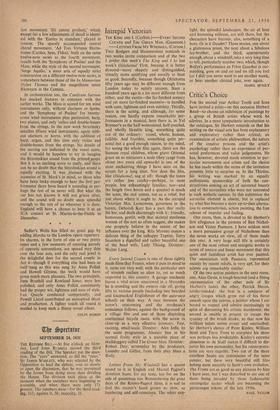The Canticum Sacrum.
As in 1951, the great event of the Venice Festival this year is a new work by Stravinsky, specially commissioned for St. Mark's Cathe- dral. Rumour had it at first that the new work was to be a Passion According to St. Mark, or, later, a setting of the Vespers. The actual title, in full, is Canticum Sacrum Ad Honorem Sancti Marci Nominis, and the text consists of eight extracts from the Vulgate, set in five movements (plus an introductory 'Dedication'), for tenor and baritone soli, chorus and orchestra.
The vocal score is already published, and shows Stravinsky working again with 'the 'serial' technique that he has adopted in mqst of his works since The Rake's Progress. The new work differs from most of these, however. in that here he makes use of actual twelve-note series. Previously he has used both longer and shorter series—one of sixteen notes in the Septet, one of five notes in the In Memoriam Dylan Thomas, and one of four notes in the first of the Three Shakespeare Songs. The Canticum Sacrum thus marks a step nearer to Schoenberg's concept of serialism, although Stravinsky's method still differs radically from Schoenberg's in that he uses his series, with rare exceptions, only melodically, or as he calls it 'canonically.'
In general tone and character the new work is as unmistakably Stravinskian as ever. It has something in common with all three of his earlier important religiqus choral works—the 'Symphony of Psalms' (1930), the Mass (1948) and the Cantata (1952). The `Symphony of Psalms' in particular is often recalled—in the movement proper 'Euntes in mundum,' the fourth movement 'Brevis Motus Cantilenie: for baritone solo with chorus and orchestra. strictly built on one twelve-note series, and the
last movement '111i autem profecti,' which except for a few adjustments of detail is identi- cal with the 'Euntes in mundum,' played in reverse. The sparely accompanied central choral movement, 'Ad Tres Virtutes Herta- tiones (Caritas, Spes, Fides),' built on the same twelve-note series as the fourth movement, recalls both the 'Symphony of Psalms' and the Mass, while the style of the second movement, 'Surge Aquilo,' a tenor aria of equally strict construction on a different twelve-note series, is somewhere between those of the In Memoriam Dylan Thomas and the magnificent tenor Ricercare in the Cantata.
In orchestration too, the Canticum Sacrum has marked features in common with the earlier works. The Mass is scored for ten wind instruments only, without clarinets or horns, and the 'Symphony of Psalms' for twenty- seven wind instruments plus percussion, harp, two pianos, and only 'cellos and double-basses from the strings. In the new work Stravinsky specifies fifteen wind instruments, again with- out clarinets or horns, with the addition of harp, organ, and this time only violas and double-basses from the strings. No details of the scoring are indicated in the vocal score, and it would be hopeless to try to imagine the Stravinskian sound from the printed notes. But it is an exciting score to study, and there can be no doubt that the Stravinskian sound is equally exciting. It was planned with the acoustics of St. Mark's in mind, so those who have been lucky enough to hear the first per- formance there have heard it sounding as per- Imps the rest of us never will. But what the car has not known it will not grieve after, and the sound will no doubt seem splendid enough to the rest of us wherever it is done. England will have a chance to hear it at an JCA concert at St. Martin-in-the-Fields in December.
* * *
Sadler's Wells has filled no great gap by adding Martha to the London opera repertory. Its charms, in the form of one or two pretty tunes and a few moments of amusing parody of operatic conventions, are spread very thin over the four acts, and the only real jewel is the delightful duet for the second couple in Act 4—though if everything else had been as well sung as this was sung by Anna Pollak and Howell Glynne, the work would have given much more pleasure. The two principals, June Bronhill and Rowland Jones, were less polished, and only Anna Pollak consistently had the proper wit, lightness and ease of style. Leo Quayle conducted competently. and Powell Lloyd contributed an uninspired decor and production. A lighter touch all round is needed to keep such a flimsy vessel afloat.
COLIN MASON



































 Previous page
Previous page